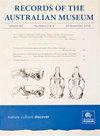Late Quaternary fossil vertebrates of the Broken River karst area, northern Queensland, Australia
IF 0.8
4区 生物学
Q4 ZOOLOGY
引用次数: 4
Abstract
Two new fossil deposits from caves of the Broken River area, northeast Queensland, provide the first regional records of vertebrate species turnover and extinction through the late Quaternary. Fossil assemblages from Big Ho and Beehive Caves are dominated by small-bodied vertebrates, especially mammals. They represent owl roost deposits, although limited presence of larger-bodied taxa such as macropodids may be the result of occasional pitfall trapping. U-series dating demonstrates that Big Ho dates to the penultimate glacial cycle (c. 165 ka) and Beehive to the early Holocene (c. 8.5 ka). A total of 34 mammalian taxa were identified; within the two deposits, seven taxa are unique to Big Ho and another seven are found only in Beehive. The deposits also preserve five extinct fossil taxa (bandicoots and rodents) that add to a growing list of small-bodied species known to have suffered extinction in the late Quaternary. The deposits further yield the remains of four species of bandicoots and rodents (Chaeropus yirratji, Notomys longicaudatus, Conilurus albipes, and Pseudomys gouldii) that suffered extinction postEuropean colonization. These new fossil records represent significant increases in the known geographic and temporal range of several species and begin to fill an important gap in our understanding of the faunal history of tropical northeast Australia. Records of the Australian Museum (2020) vol. 72, issue no. 5, pp. 193–206 https://doi.org/10.3853/j.2201-4349.72.2020.1723 Records of the Australian Museum a peer-reviewed open-access journal published by the Australian Museum, Sydney communicating knowledge derived from our collections ISSN 0067-1975 (print), 2201-4349 (online)澳大利亚昆士兰北部破碎河喀斯特地区晚第四纪脊椎动物化石
在昆士兰东北部布罗肯河地区的洞穴中发现的两个新的化石沉积,首次提供了晚第四纪脊椎动物物种更替和灭绝的区域记录。大霍洞和蜂巢洞的化石组合主要是小体脊椎动物,尤其是哺乳动物。它们代表了猫头鹰的栖息地,尽管像大足类动物这样的大体型类群的有限存在可能是偶然陷阱捕获的结果。u系列测年结果表明,Big Ho的年代为第二次冰期旋回(c. 165 ka), Beehive的年代为全新世早期(c. 8.5 ka)。共鉴定出34个哺乳动物类群;在这两个沉积物中,有7个分类群是大霍特有的,另外7个分类群只在蜂巢发现。这些沉积物还保存了五种灭绝的化石分类群(土拨鼠和啮齿动物),为第四纪晚期灭绝的小型物种增加了一份越来越多的名单。这些沉积物进一步发现了四种土拨鼠和啮齿动物的遗骸(Chaeropus yirratji, Notomys longicaudatus, Conilurus albipes和Pseudomys gouldii),这些动物在欧洲殖民后灭绝。这些新的化石记录代表了一些物种已知的地理和时间范围的显著增加,并开始填补我们对澳大利亚热带东北部动物历史的理解中的一个重要空白。《澳大利亚博物馆志》(2020)第72卷,发行号:5,第193-206页https://doi.org/10.3853/j.2201-4349.72.2020.1723澳大利亚博物馆的记录,澳大利亚博物馆出版的同行评审的开放获取期刊,悉尼交流知识来源于我们的藏品ISSN 0067-1975(印刷),2201-4349(在线)
本文章由计算机程序翻译,如有差异,请以英文原文为准。
求助全文
约1分钟内获得全文
求助全文
来源期刊
CiteScore
0.90
自引率
0.00%
发文量
9
审稿时长
>12 weeks
期刊介绍:
Records of the Australian Museum, volume 62 was published in 2010, volume 63 in 2011. Monographic works of particular significance are published irregularly as Records of the Australian Museum, Supplements (ISSN 0812-7387).

 求助内容:
求助内容: 应助结果提醒方式:
应助结果提醒方式:


